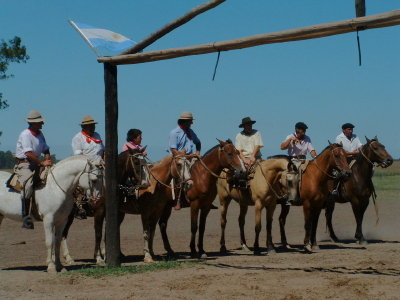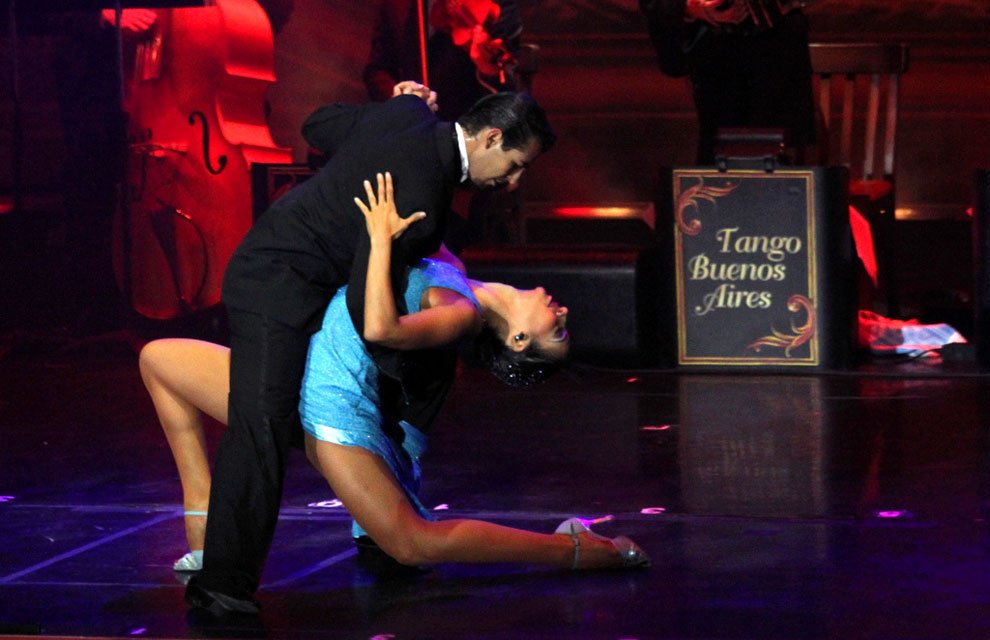 |
Jeff Gorin's trip to Buenos Aires, Argentina - Spring 2003
My first travel south of the equator was in the springtime of 2003 (the fall season south of the equator), after becoming fascinated with this region as described in travel articles on Argentina and Buenos Aires, its capital city. Buenos Aires is unique in South America as both a quite large metropolis -- about 13 million inhabitants in the entire metro area -- and the most "European-flavored” city on the continent. A large percentage of the population is descended from Spanish and Italian immigrants to the area over the past 400+ years.
Today, Buenos Aires is located where the first permanent settlement by Europeans was established in 1580 by the Spaniard Juan de Garay, who sailed down the Paraná River from Asunción (now the capital of Paraguay. Garay called the city Ciudad de la Santísima Trinidad y Puerto de Santa María de los Buenos Aires ("City of the Most Holy Trinity and Port of Saint Mary of the Fair Winds". The short form "Buenos Aires" became the common usage during the 17th century. It is also frequently referred to by the even more abbreviated "BA”. Access by commercial air travel to this part of South America is most direct from by non-stop flights from Miami in the USA. I arrived for a fortnight visit on April 13 from Miami on a quite comfortable non-stop overnight United flight (4400 miles in about 9 hours on a B767 aircraft). My RT airfare from Miami to BA was roughly $600; today, a decade later, the best flight deals are 50% - 60% more expensive. International flights from the USA to BA arrive at the city’s international airport, about a 45 minute drive from the city center. Tip: As with any international flight into a large city, visitors should be careful to select ONLY known-reliable public transportation into the center city. If you plan to stay at a hotel with its own arrangements for airport pickup (fee-based), use it! Likewise, ask your hotel front desk staff to call a cab when you need to take one. By following this formula, I had no bad taxi experiences. In most situations you won’t want a rental car in BA, as city parking can be problematic and expensive, while public transport is both economical and very reliable. In planning my visit to BA, I was interested in both managing my expenses to stay in the low range, and improving my Spanish language skills. Internet research showed that among Spanish language schools in BA, at least one (ILEE Argentina) offered an economical approach to a combination of half-day language classes, along with low-cost lodging in a very nice nearby hotel in the center of the BA business district. I elected two weeks of morning classes, which with a max of only six students per class allowed plenty of personal interaction with the instructor. The morning classes were Monday-Friday only, leaving plenty of time for sightseeing around the city. Another attractive feature of Argentina for economy-minded tourists, at the time of my visit, was the quite favorable exchange rate at 3 Argentine pesos to 1 US dollar. In 2003, Argentina was in the early stages of recovery from a recently collapsed economy, which resulted in relatively low prices for tourists from the USA. Consequently, a decade ago I found that most goods and services of interest to tourists cost about a third of what we would pay in the USA. Though the exchange rate is now hovering around 5 pesos to 1 dollar, and recent inflation has pushed prices up, today’s tourists will still find very attractive bargains in BA and throughout Argentina. My BA hotel was Republica (now called "Hotel Globales Republica"), in an excellent central location at Obelisk Plaza on Avenida 9 de Julio, which is possibly the planet’s widest urban avenue at 9 lanes in each direction! (Its name honors July 9, the Argentine Independence Day.) The major cross street near the hotel is Corrientes, a principal avenue for cultural and entertainment activities. The hotel staff was multilingual Spanish/English, and very helpful. From the internet, it appears that the hotel has been remodeled and upgraded since my visit, but is still moderately priced for the BA business and pleasure tourist market. As with other BA hotels, Republica hotel rooms can be reserved either with or without the breakfast buffet; the buffet is a good value for the additional fee. If you stay at the Republica, or another high-rise on 9 de Julio, I recommend a room on the higher floors to mitigate the street noise. The city view from upper floors, including that of the iconic Obelisk -- a miniature Washington Monument -- and of the wide avenue below, is outstanding. Staying at a central location in BA affords quick access to the local subway system, which is known locally as the SUBTE, short for "subterranean transport”. Economical and efficient to use, the BA subway system is celebrating a century of operation in 2013. Three of the six subway lines intersect in proximity to the crossroads of Corrientes and 9 de Julio. Known worldwide as the birthplace of Tango, Buenos Aires offers numerous studios where Tango dance lessons are offered. Even if you’re not interested in brushing up on your Tango skills, take in an evening dinner-and-Tango show at one of the traditional clubs offering professional performances. I can vouch for the quality of both the cuisine and the show at "El Querandí", a club that dates from the 1920s. Worthwhile attractions around the city include … * Casa Rosada, the official seat of the executive branch of the Argentine government. It is located at one end of the Plaza de Mayo, where significant political demonstrations have occurred through Argentina‘s history. * Teatro Colón (Columbus Theater), an internationally renowned opera house opened in 1908 and venue for outstanding classical musical performances. Even if you don’t attend a performance, try to take a daytime guided tour to enjoy the remarkable architecture. * Recoleta Cemetery, which includes graves of many of Argentina's historical figures, including Eva Perón (aka "Evita"), plus several presidents and scientists, as well many among Argentina's influential families. I highly recommend a half-day English-narrated bus tour of BA early in a visit to the city, to achieve a general orientation to the key neighborhoods and attractions of the metropolitan district. A hotel concierge can arrange such a tour on short notice, most likely with pickup at your hotel or a nearby pickup point. Short side-trips away from BA can add variety to an Argentine visit. I can recommend two from personal experience: A day trip to the Santa Susana Estancia, and a quick weekend trip to experience the Iguazú Falls in northeastern Argentina. In medium or large hotels in BA, the concierge or front desk personnel can help you set up such excursions, or point you to a local English-speaking travel agent who can. Santa Susana Day Trip -- Estancia is the Spanish word for a large cattle ranch estate. The purpose of this day trip is to experience a typical "gaucho fiesta” at Estancia Santa Susana, a gaucho ranch of almost 3000 acres located in the district of Campana, just an hour’s drive by tour bus from central Buenos Aires. This visit affords an experience of the authentic traditions of the Argentine cowboys and their typical gaucho skills, including a folkloric performance of typical gaucho dances, Tango and other traditional rhythms, plus a full gaucho barbecue luncheon meal that includes the best Argentine beef, salads, drinks and much quality Argentine wine! A horse-drawn carriage ride through the pampas is even offered. During the estancia visit, one can gain an understanding of how the cowboys of Argentina, who made up the majority of the rural population during the 18th, 19th and early 20th Centuries, made a living from hunting and from herding cattle. Iguazú Falls -- To say that my weekend visit to the Puerto Iguazú region of NE Argentina was awe-inspiring would be an understatement. The Falls on the Rio Iguazú can be viewed in a beautifully-organized national park, located along the river which forms the boundary between Argentina and Brazil. It's amazing to think that an AVERAGE volume of water passing over these cataracts is well in excess of 150,000 cubic feet per second, and that after a good rain, the volume can easily increase to 230,000 cu ft per sec. Compare this to the average of 65,000 cu ft per sec over Niagara Falls. There are over 270 separate cascades throughout the overall horizontal extent of the Falls! These Falls are like a Niagara on steroids -- but in a sub-tropical rain forest setting that has a lot of other interesting aspects besides the cataracts themselves. The flora and fauna are also a feast for the senses. For example, it is said that there are over 50 species of wild orchids that grow in this rain forest; I noted a number of them myself during hikes. There are also numerous bird species that like the sub-tropical forest and river environments ... including toucans, hummingbirds, kingfishers and egrets which I viewed during the visit. All features of my weekend mini-tour to the Iguazú region were arranged by a local BA travel agent after my arrival in Argentina. The tour included round-trip commercial air (a 2-hour flight) from the small "city airport" in BA, hotel lodging and an all-day escorted tour of the national park with numerous different views of the Falls. The tour guide picked me up in a minibus at my hotel, and dropped me off there at the end of the day. I stayed for two nights in the Hotel Esturion in the town of Puerto Iguazú, which itself has a significant point of interest while being a 20-minute drive from the national park. This well-appointed but not extravagant hotel looks down on the Iguazú River from approximately 75 meters above the river level. The hotel has an excellent restaurant, with good food and service, as well as a large outdoor swimming pool. Puerto Iguazú is located a short distance downstream on the Rio Iguazú from the Falls, at the confluence of two mighty rivers: Iguazú and Paraná. Since these rivers form national boundaries between the countries of Argentina, Brazil and Paraguay, the point in the middle of the confluence channel where the boundaries meet is in itself a point of interest. Five hundred meters from my hotel is a beautiful little park on a bluff overlooking the point where the rivers meet. It´s called the Parque de Las Tres Fronteras, or the Three Frontiers Park. Beautifully planted with numerous samples of the native sub-tropical flora, the park provides an interesting vista of three countries. So while I actually planted my feet in Argentina, I simultaneously "visited" (at least visually) both Brazil and Paraguay across the river channels. In summary, my two weeks offered only a taste of the amazing variety of social, cultural and visual experiences offered by Argentina. For myself traveling solo, the cost of the entire trip from Arizona through Miami, then to BA and return, did not exceed $3,000 in 2003 dollars. -------------------------------------------------------------------------------------------
AUTHOR CONTACT: Phone +1-480-831-6623 or Email lewisjg@aol.com
(Preferred phone contact time is 8pm-10pm MST in the USA)
Rating:
Classmate Comments:Travel Forum: |
 |






